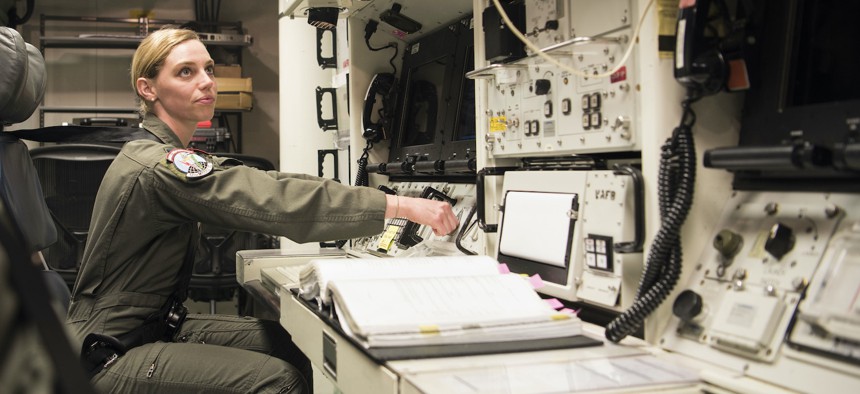
1st Lt. Claire Waldo, 12th Missile Squadron missile combat crew commander, conducts a dry-run for an ICBM test launch in the Launch Control Center, Feb. 3, 2020, at Vandenberg Air Force Base, Calif. U.S. Air Force / Airman 1st Class Aubree Milks
Pentagon To Launch New Study On How to Get at Hard, Deeply Buried Targets
A senior defense official explains the thinking behind the Biden Administration’s nuclear policy document.
The newly released Nuclear Posture Review contained few surprises, but did call for the retirement of one element in the U.S. nuclear arsenal: the B83 megaton gravity bomb. Now, because of that decision, the United States must look at new means to get at deeply buried targets, a senior defense official said Tuesday.
“We're going to be doing a major study looking at what capabilities we could bring to bear to that challenge, whether those are nuclear or non-nuclear,” Richard Johnson, the deputy assistant secretary of defense for nuclear and counter weapons of mass destruction policy, said Tuesday at an Atlantic Council event.
The B83 can cause a 1.2 megaton explosion, nearly 80 times larger than the 15 kiloton explosion caused by the “Little Boy” bomb that the United States dropped on Hiroshima in World War II. Over time, Johnson said, large atomic gravity bombs have seen a “diminishment of usefulness.” The United States is moving in the direction of smarter weapons, like the so-called long-range stand-off weapon, an air-launched nuclear cruise missile, while China and Russia are focusing more on highly-maneuverable nuclear hypersonic missiles.
But big gravity bombs are useful for getting at hard and deeply-buried targets, referred to as HDBs. So the United States now needs strategies for those.
The review also discontinues research into the low-yield, sea-launched cruise missile, which had been in a developmental phase. That missile could also have gone onto lighter, smaller attack submarines that have not traditionally hosted nuclear weapons, Johnson said, which “kind of changes the mission a little bit of our submarines. We have different kinds of submarines for different missions, and there was lots of discussion about whether that would, you know, impact the effectiveness of those attack submarines,” in part because adversaries might assume that all U.S. attack submarines could be armed with nuclear missiles.
Overall, the review makes clear that the United States will continue to modernize its bomber and submarine fleet and will replace the intercontinental ballistic missiles that make up the final leg of the triad with new missiles, as opposed to attempting to extend the life of the older ones. Johnson explained that the cost to repair the ICBMs was greater than just replacing them.
By dropping the sea-launched cruise missile, the Biden administration took a softer line than some hawks, such as former Defense Secretary James Mattis, had advocated for. But some in the non-proliferation community still saw the review as a disappointment.
“Previous efforts to reduce nuclear arsenals and the role that nuclear weapons play have been subdued by renewed strategic competition abroad and opposition from defense hawks at home,” the Federation of American Scientists noted in a brief last week.
Stephen I. Schwartz, a nonresident senior fellow at the Bulletin of the Atomic Scientists, told Motherboard that the review doesn’t do enough to challenge the military’s assumptions and preferences on nuclear weapons. Instead, he said, it “effectively rubber stamp[ed] both the posture and the weapons systems that are in place.”


